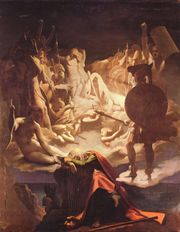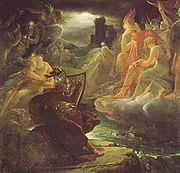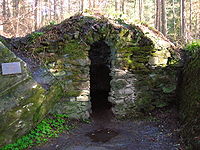
Ossian
Encyclopedia

Scottish people
The Scottish people , or Scots, are a nation and ethnic group native to Scotland. Historically they emerged from an amalgamation of the Picts and Gaels, incorporating neighbouring Britons to the south as well as invading Germanic peoples such as the Anglo-Saxons and the Norse.In modern use,...
poet James Macpherson
James Macpherson
James Macpherson was a Scottish writer, poet, literary collector and politician, known as the "translator" of the Ossian cycle of poems.-Early life:...
claimed to have translated from ancient sources in the Scots Gaelic
Scottish Gaelic language
Scottish Gaelic is a Celtic language native to Scotland. A member of the Goidelic branch of the Celtic languages, Scottish Gaelic, like Modern Irish and Manx, developed out of Middle Irish, and thus descends ultimately from Primitive Irish....
. He is based on Oisín
Oisín
Oisín , also spelt in English Ossian or Osheen, was regarded in legend as the greatest poet of Ireland, and is a warrior of the fianna in the Ossianic or Fenian Cycle of Irish mythology...
, son of Finn or Fionn mac Cumhaill
Fionn mac Cumhaill
Fionn mac Cumhaill , known in English as Finn McCool, was a mythical hunter-warrior of Irish mythology, occurring also in the mythologies of Scotland and the Isle of Man...
, anglicised to Finn McCool, a character from Irish mythology
Irish mythology
The mythology of pre-Christian Ireland did not entirely survive the conversion to Christianity, but much of it was preserved, shorn of its religious meanings, in medieval Irish literature, which represents the most extensive and best preserved of all the branch and the Historical Cycle. There are...
. Although the poems were well-received, many critics voiced concerns about their authenticity, a debate that continued into the 20th century.
The poems

In 1761 he claimed to have found an epic
Epic poetry
An epic is a lengthy narrative poem, ordinarily concerning a serious subject containing details of heroic deeds and events significant to a culture or nation. Oral poetry may qualify as an epic, and Albert Lord and Milman Parry have argued that classical epics were fundamentally an oral poetic form...
on the subject of the hero Fingal, written by Ossian. The name Fingal or Fionnghall means "white stranger".
He published translations of it during the next few years, culminating in a collected edition; The Works of Ossian, in 1765. The most famous of these poems was Fingal, written in 1762.
Reception
The poems achieved international success (Napoleon and Thomas JeffersonThomas Jefferson
Thomas Jefferson was the principal author of the United States Declaration of Independence and the Statute of Virginia for Religious Freedom , the third President of the United States and founder of the University of Virginia...
were great fans) and were proclaimed as a Celtic equivalent of the Classical
Classical antiquity
Classical antiquity is a broad term for a long period of cultural history centered on the Mediterranean Sea, comprising the interlocking civilizations of ancient Greece and ancient Rome, collectively known as the Greco-Roman world...
writers such as Homer
Homer
In the Western classical tradition Homer , is the author of the Iliad and the Odyssey, and is revered as the greatest ancient Greek epic poet. These epics lie at the beginning of the Western canon of literature, and have had an enormous influence on the history of literature.When he lived is...
. Many writers were influenced by the works, including the young Walter Scott
Walter Scott
Sir Walter Scott, 1st Baronet was a Scottish historical novelist, playwright, and poet, popular throughout much of the world during his time....
and the German writer Johann Wolfgang von Goethe
Johann Wolfgang von Goethe
Johann Wolfgang von Goethe was a German writer, pictorial artist, biologist, theoretical physicist, and polymath. He is considered the supreme genius of modern German literature. His works span the fields of poetry, drama, prose, philosophy, and science. His Faust has been called the greatest long...
, whose own German translation of a portion of Macpherson's work figures prominently in a climactic scene of The Sorrows of Young Werther
The Sorrows of Young Werther
The Sorrows of Young Werther is an epistolary and loosely autobiographical novel by Johann Wolfgang von Goethe, first published in 1774; a revised edition of the novel was published in 1787...
(1774).
Goethe's associate Johann Gottfried Herder
Johann Gottfried Herder
Johann Gottfried von Herder was a German philosopher, theologian, poet, and literary critic. He is associated with the periods of Enlightenment, Sturm und Drang, and Weimar Classicism.-Biography:...
wrote an essay titled Extract from a correspondence about Ossian and the Songs of Ancient Peoples in the early days of the Sturm und Drang
Sturm und Drang
Sturm und Drang is a proto-Romantic movement in German literature and music taking place from the late 1760s through the early 1780s, in which individual subjectivity and, in particular, extremes of emotion were given free expression in reaction to the perceived constraints of rationalism...
movement.
The poem was as much admired in Hungary as in France and Germany; Hungarian János Arany
János Arany
János Arany , was a Hungarian journalist, writer, poet, and translator. He is often said to be the "Shakespeare of ballads" – he wrote more than 40 ballads which have been translated into over 50 languages, as well as the Toldi trilogy, to mention his most famous works.-Biography:He was born in...
wrote "Homer and Ossian" in response, and several other Hungarian writers – Baróti Szabó, Csokonai
Mihály Csokonai Vitéz
Mihály Csokonai Vitéz was a Hungarian poet.Having been educated in Debrecen, where he was born, Csokonai was appointed while still very young to the professorship of poetry there...
, Sándor Kisfaludy
Sándor Kisfaludy
Sándor Kisfaludy was a Hungarian lyric poet, Himfy's Loves his chief work, was less distinguished as a dramatist. He is considered to be the first romantic poet from Hungary. He was the brother of Károly Kisfaludy. He has been set to music by Zoltán Kodály.-References:...
, Kazinczy
Ferenc Kazinczy
Ferenc Kazinczy was a Hungarian author, the most indefatigable agent in the regeneration of the Magyar language and literature at the end of the 18th and beginning of the 19th century...
, Kölcsey, Ferenc Toldy
Ferenc Toldy
Ferenc Toldy was a German-Hungarian literary critic....
, and Ágost Greguss, were also influenced by it.
In Italy the translation of Ossian by Melchiore Cesarotti
Melchiore Cesarotti
Melchiore Cesarotti was an Italian poet and translator.-Biography:He was born at Padua, of a noble but impoverished family. At the University of Padua his literary progress gained him the chair of rhetoric, and in 1768 the professorship of Greek and Hebrew...
made that work highly popular, and among others it influenced Ugo Foscolo
Ugo Foscolo
Ugo Foscolo , born Niccolò Foscolo, was an Italian writer, revolutionary and poet.-Biography:Foscolo was born on the Ionian island of Zakynthos...
who was Cesarotti's pupil in the University of Padua
University of Padua
The University of Padua is a premier Italian university located in the city of Padua, Italy. The University of Padua was founded in 1222 as a school of law and was one of the most prominent universities in early modern Europe. It is among the earliest universities of the world and the second...
.
The first partial Polish
Polish language
Polish is a language of the Lechitic subgroup of West Slavic languages, used throughout Poland and by Polish minorities in other countries...
translation of Ossian was made by Ignacy Krasicki
Ignacy Krasicki
Ignacy Krasicki , from 1766 Prince-Bishop of Warmia and from 1795 Archbishop of Gniezno , was Poland's leading Enlightenment poet , a critic of the clergy, Poland's La Fontaine, author of the first Polish novel, playwright, journalist, encyclopedist, and translator from French and...
in 1793. The complete translation appeared in 1830 by Seweryn Goszczyński
Seweryn Goszczynski
Seweryn Goszczyński was a Polish Romantic prose writer and poet.Goszczyński did not receive a thorough education because his parents were not well off. He studied with breaks in different schools, the Basilian School in Humań being the one where he stayed the longest period of time. At this school...
.
The most influential Russian version of Ossian was the 1792 translation by Ermil Kostrov, who based his work on Pierre Le Tourneur's 1777 translation from the original.
The play Ossian, ou Les bardes
Ossian, ou Les bardes
Ossian, ou Les bardes is an opera in five acts by the French composer Jean-François Le Sueur. The libretto, by Alphonse François "Paul" Palat-Dercy and Jean-Marie Deschamps, is based on the Ossian poems of James Macpherson , which had been translated into French by Pierre-Prime-Félicien Le...
by Le Sueur
Jean-François Le Sueur
Jean-François Le Sueur was a French composer, best known for his oratorios and operas.-Life:...
was a sell-out at the Paris Opera
Paris Opera
The Paris Opera is the primary opera company of Paris, France. It was founded in 1669 by Louis XIV as the Académie d'Opéra and shortly thereafter was placed under the leadership of Jean-Baptiste Lully and renamed the Académie Royale de Musique...
in 1804, and transformed his career. This led to its influence on Napoleon and Girodet's
Anne-Louis Girodet de Roussy-Trioson
Anne-Louis Girodet de Roussy-Trioson January 5, 1767 – December 9, 1824), was a French painter and pupil of Jacques-Louis David, who was part of the beginning of the Romantic movement by adding elements of eroticism through his paintings...
1805 painting Ossian receiving the Ghosts of the French Heroes (see above).
The poems also exerted an influence on the burgeoning of Romantic music
Romantic music
Romantic music or music in the Romantic Period is a musicological and artistic term referring to a particular period, theory, compositional practice, and canon in Western music history, from 1810 to 1900....
, and Franz Schubert
Franz Schubert
Franz Peter Schubert was an Austrian composer.Although he died at an early age, Schubert was tremendously prolific. He wrote some 600 Lieder, nine symphonies , liturgical music, operas, some incidental music, and a large body of chamber and solo piano music...
, in particular composed Lieder setting many of Ossian's poems. In 1829 Felix Mendelssohn
Felix Mendelssohn
Jakob Ludwig Felix Mendelssohn Barthóldy , use the form 'Mendelssohn' and not 'Mendelssohn Bartholdy'. The Grove Dictionary of Music and Musicians gives ' Felix Mendelssohn' as the entry, with 'Mendelssohn' used in the body text...
was inspired to visit the Hebrides and composed the Hebrides Overture
Hebrides Overture
The Hebrides Overture , Op. 26, also known as Fingal's Cave , is a concert overture composed by Felix Mendelssohn. Written in 1830, the piece was inspired by a cavern known as Fingal's Cave on Staffa, an island in the Hebrides archipelago located off the west coast of Scotland...
, better known as "Fingal's Cave". His friend Niels Gade devoted his first published work, the concert overture Efterklange af Ossian ("Echoes of Ossian") written in 1840, to the same subject.
In the 20th century Ossian became an exemplar of an imagined golden age of primitive pre-industrial culture to groups ranging from the Thule Society
Thule Society
The Thule Society , originally the Studiengruppe für germanisches Altertum , was a German occultist and völkisch group in Munich, named after a mythical northern country from Greek legend...
to the environmental movement
Environmental movement
The environmental movement, a term that includes the conservation and green politics, is a diverse scientific, social, and political movement for addressing environmental issues....
.
Authenticity debate

Macpherson promoted a Scottish origin for the material, and was hotly opposed by Irish historians who felt that their heritage was being appropriated. However, both Scotland and Ireland shared a common Gaelic
Gaels
The Gaels or Goidels are speakers of one of the Goidelic Celtic languages: Irish, Scottish Gaelic, and Manx. Goidelic speech originated in Ireland and subsequently spread to western and northern Scotland and the Isle of Man....
culture during the period in which the poems are set and some Fenian
Fenian Cycle
The Fenian Cycle , also referred to as the Ossianic Cycle after its narrator Oisín, is a body of prose and verse centering on the exploits of the mythical hero Fionn mac Cumhaill and his warriors the Fianna. It is one of the four major cycles of Irish mythology along with the Mythological Cycle,...
literature common in both countries was composed in Scotland.
The English author, critic, and biographer, Samuel Johnson
Samuel Johnson
Samuel Johnson , often referred to as Dr. Johnson, was an English author who made lasting contributions to English literature as a poet, essayist, moralist, literary critic, biographer, editor and lexicographer...
, was convinced that Macpherson was "a mountebank, a liar, and a fraud, and that the poems were forgeries". Johnson also dismissed the poems' quality. Upon being asked, "But Doctor Johnson, do you really believe that any man today could write such poetry?" he famously replied, "Yes. Many men. Many women. And many children." Johnson is cited as calling the story of Ossian "as gross an imposition as ever the world was troubled with". The American literature professor and translator Bernard Knox
Bernard Knox
Bernard MacGregor Walker Knox was an English classicist, author, and critic who became an American citizen. He was the first director of the Center for Hellenic Studies. In 1992 the National Endowment for the Humanities selected Knox for the Jefferson Lecture, the U.S...
alternatively refers to this book as a forged or fake "collective bardic epic".
Faced with the controversy, the Committee of the Highland Society enquired after the authenticity of Macpherson's supposed original. It was thanks to these circumstances that the so-called Glenmasan manuscript
Glenmasan manuscript
The Glenmasan manuscript is a 15th-century Scottish vellum manuscript in the National Library of Scotland, Edinburgh, where it is catalogued as Adv. MS 72.2.3. It was previously held in the Advocates Library, Edinburgh, where it was classified as MS 53...
(Adv. 72.2.3) came to light, a compilation which contains the tale Oided mac n-Uisnig.

Donald Smith
Donald Smith may refer to:* Donald Smith , head college football coach at Kentucky State University * Donald Smith , English cricketer* Donald Smith , Australian tenor...
cited it in his report for the Committee.
The controversy raged on into the early years of the 19th century, with disputes as to whether the poems were based on Irish sources, on sources in English, on Gaelic fragments woven into his own composition as Johnson concluded, or largely on Scots Gaelic oral traditions and manuscripts as Macpherson claimed.
Scottish author Hugh Blair
Hugh Blair
Hugh Blair FRSE was a Scottish minister of religion, author and rhetorician, considered one of the first great theorists of written discourse....
's 1763 A Critical Dissertation on the Poems of Ossian upheld the work's authenticity against Johnson's scathing criticism and from 1765 was included in every edition of Ossian to lend the work credibility. The work also had a timely resonance for those swept away by the emerging Romantic movement
Romanticism
Romanticism was an artistic, literary and intellectual movement that originated in the second half of the 18th century in Europe, and gained strength in reaction to the Industrial Revolution...
and the theory of the "noble savage
Noble savage
The term noble savage , expresses the concept an idealized indigene, outsider , and refers to the literary stock character of the same...
", and it echoed the popularity of Burke's
Edmund Burke
Edmund Burke PC was an Irish statesman, author, orator, political theorist and philosopher who, after moving to England, served for many years in the House of Commons of Great Britain as a member of the Whig party....
seminal A Philosophical Enquiry into the Origin of Our Ideas of the Sublime and Beautiful
A Philosophical Enquiry into the Origin of Our Ideas of the Sublime and Beautiful
A Philosophical Enquiry into the Origin of Our Ideas of the Sublime and Beautiful is a 1757 treatise on aesthetics written by Edmund Burke. It attracted the attention of prominent Continental thinkers such as Denis Diderot and Immanuel Kant....
(1757).
In 1952, Scottish poet Derick Thomson
Derick Thomson
Professor Derick S. Thomson MA, BA, Dlitt, FRSE, FBA , known as Ruaraidh MacThòmais in his native Scottish Gaelic, is a Scottish poet, publisher, lexicographer, academic and writer. He is originally from Lewis, but has spent much of his life in Glasgow, where he was Professor of Celtic at the...
concluded that Macpherson had collected Scottish Gaelic ballads, employing scribes to record those that were preserved orally and collating manuscripts, but had adapted them by altering the original characters and ideas, and had introduced a great deal of his own.
The Invention of Scotland (2008) by Hugh Trevor-Roper conclusively follows the evolution of MacPherson's version(s) and the work's early support by some Scottish intellectuals.
Editions
- 1996: The Poems of Ossian and Related Works, ed. Howard Gaskill, with an Introduction by Fiona Stafford (Edinburgh: Edinburgh Univ. Press).
- 2004: Ossian and Ossianism, Dafydd Moore, (London: Routledge). A 4-volume edition of Ossianic works and a collection of varied responses (London: Routledge, 2004). This includes facsimiles of the Ossian works, contemporary and later responses, contextual letters and reviews, and later adaptations.
- 2011: Blind Ossian's Fingal : fragments and controversy a reprint of the first edition and abridgement of the follow-up with new material by Allan and Linda Burnett (Edinburgh: Luath Press Ltd)
External links
- The Poetical Works of Ossian Full text at Ex-Classics
- Selected Bibliography: James Macpherson and Ossian Excellent online bibliography; compiled by designated experts in the field; covering the most important scholarly monographs and articles on Ossian and Macpherson up to March 2004.
- Literary Encyclopedia: Ossian
- Popular Tales of the West Highlands by J. F. Campbell Volume IV (1890)
- A Vision of Britain Through Time James Boswell, The Journal of a Tour to the Hebrides with Samuel Johnson, discussion in entries for 22 and 23 September 1773.
- Calum Colvin: "Ossian: Fragments of Ancient Poetry" Reproduction of the cycle of paintings "Ossian: Fragments of Ancient Poetry" (2002) by one of Scotland's most renowned contemporary artists

